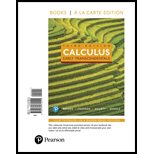
Concept explainers
a.
Whether the statement “If
a.
Answer to Problem 1RE
The statement is false.
Explanation of Solution
The given
Substitute
Thus, the constant vector is
Hence the statement if
b.
Whether the statement “The curvature of a circle of radius 5 is
b.
Answer to Problem 1RE
The given statement is true.
Explanation of Solution
Definition used:
“The curvature of a curve at a point can be visualized in terms of a circle of curvature, which is a circle of radius R that is tangent to the curve at that point.
The curvature at the point is
Description:
The given circle has the radius of 5.
By the above definition used, the curvature of a circle is reciprocal of the radius of the circle.
Thus, the curvature of the circle is
Hence, the statement “the curvature of a circle of radius 5 is
c.
Whether the statement “The graph of the curve
c.
Answer to Problem 1RE
The given statement is true.
Explanation of Solution
Definition used:
One point to a curve corresponds to a single vector
The entire curve can be represented by a vector-valued function
Calculation:
The given graph is
The values are
Here,
That is
Therefore, the statement “the graph of the curve
d.
Whether the given statement “If
d.
Answer to Problem 1RE
The given statement is true.
Explanation of Solution
Consider
Thus, the vector
Therefore, the given statement is true.
e.
Whether the statement “The parameterized curve
e.
Answer to Problem 1RE
The given statement is false.
Explanation of Solution
Suppose
Differentiate
Compute
Since
Therefore, the given statement is false.
f.
Whether the statement “The position vector and the principal unit normal are always parallel on a smooth curve.” is true or not.
f.
Answer to Problem 1RE
The given statement is false.
Explanation of Solution
Formula used:
Suppose r is a smooth parameterized curve and s is the arc length.
The unit tangent vector T is
The principal unit normal vector is
Counter example:
Consider
Differentiate
Use magnitude formula to obtain the value of
On further simplification,
Use unit tangent formula to compute
Thus, the unit tangent vector
Differentiate
Use magnitude formula to obtain the value of
On further simplification,
Use principal unit normal formula to compute the value of
Thus, the principal unit normal vector
It is observed that the position vector and the principal unit normal vector are not equal.
Therefore, the given statement is false.
Want to see more full solutions like this?
Chapter 14 Solutions
Calculus: Early Transcendentals, Books A La Carte Edition (3rd Edition)
Additional Math Textbook Solutions
Thinking Mathematically (6th Edition)
Elementary Statistics (13th Edition)
University Calculus: Early Transcendentals (4th Edition)
Pre-Algebra Student Edition
A First Course in Probability (10th Edition)
- Find the effective rate corresponding to the given nominal rate. (Round your answers to three decimal places.) (a) 9.5%/year compounded monthly % (b) 9.5%/year compounded daily % Need Help? Read It Watch It SUBMIT ANSWER -/6.66 Points] DETAILS MY NOTES TANAPCALC10 5.3.007. ASK YOUR TEACHE Find the present value of $90,000 due in 7 years at the given rate of interest. (Round your answers to the nearest cent.) (a) 9%/year compounded semiannually (b) 9%/year compounded quarterly LAarrow_forwardFind the accumulated amount A, if the principal P is invested at an interest rate of r per year for t years. (Round your answer to the nearest cent.) P = $160,000, r = 7%, t = 4, compounded daily A = $211113.60 Need Help? Read It SUBMIT ANSWER ASK YOUR TEACHER PRACTICE ANOTHER --/6.66 Points] DETAILS MY NOTES TANAPCALC10 5.3.005. Find the effective rate corresponding to the given nominal rate. (Round your answers to three decimal places.) (a) 8%/year compounded semiannually % (b) 9%/year compounded quarterly %arrow_forwardFind the derivative of the function. g'(t) = 9t g(t) = In(t) (9ln(t) - 1) [In(t)] 2 × Need Help? Read It Watch Itarrow_forward
- Find the accumulated amount A, if the principal P is invested at an interest rate of r per year for t years. (Round your answer to the nearest cent.) P = $3800, r = 4%, t = 10, compounded semiannually A = $ 5645.60 × Need Help? Read It SUBMIT ANSWER [3.33/6.66 Points] DETAILS MY NOTES REVIOUS ANSWERS ASK YOUR TEACHER TANAPCALC10 5.3.001.EP. PRACTICE ANOTHER Consider the following where the principal P is invested at an interest rate of r per year for t years. P = $3,100, r = 4%, t = 10, compounded semiannually Determine m, the number of conversion periods per year. 2 Find the accumulated amount A (in dollars). (Round your answer to the nearest cent.) A = $ 4604.44arrow_forwardForce with 800 N and 400 N are acting on a machine part at 30° and 60°, respectively with a positive x axis, Draw the diagram representing this situationarrow_forwardI forgot to mention to you to solve question 1 and 2. Can you solve it using all data that given in the pict i given and can you teach me about that.arrow_forward
 Calculus: Early TranscendentalsCalculusISBN:9781285741550Author:James StewartPublisher:Cengage Learning
Calculus: Early TranscendentalsCalculusISBN:9781285741550Author:James StewartPublisher:Cengage Learning Thomas' Calculus (14th Edition)CalculusISBN:9780134438986Author:Joel R. Hass, Christopher E. Heil, Maurice D. WeirPublisher:PEARSON
Thomas' Calculus (14th Edition)CalculusISBN:9780134438986Author:Joel R. Hass, Christopher E. Heil, Maurice D. WeirPublisher:PEARSON Calculus: Early Transcendentals (3rd Edition)CalculusISBN:9780134763644Author:William L. Briggs, Lyle Cochran, Bernard Gillett, Eric SchulzPublisher:PEARSON
Calculus: Early Transcendentals (3rd Edition)CalculusISBN:9780134763644Author:William L. Briggs, Lyle Cochran, Bernard Gillett, Eric SchulzPublisher:PEARSON Calculus: Early TranscendentalsCalculusISBN:9781319050740Author:Jon Rogawski, Colin Adams, Robert FranzosaPublisher:W. H. Freeman
Calculus: Early TranscendentalsCalculusISBN:9781319050740Author:Jon Rogawski, Colin Adams, Robert FranzosaPublisher:W. H. Freeman
 Calculus: Early Transcendental FunctionsCalculusISBN:9781337552516Author:Ron Larson, Bruce H. EdwardsPublisher:Cengage Learning
Calculus: Early Transcendental FunctionsCalculusISBN:9781337552516Author:Ron Larson, Bruce H. EdwardsPublisher:Cengage Learning





